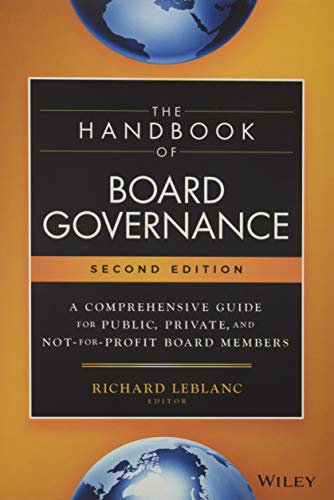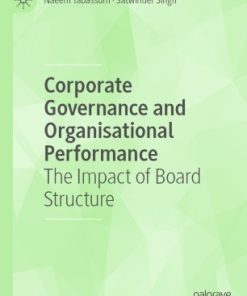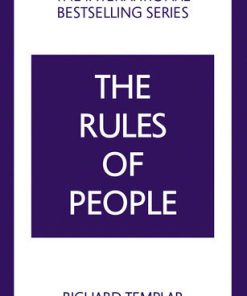(Ebook PDF) The Handbook of Board Governance A Comprehensive Guide for Public Private and Not for Profit Board Members A Comprehensive Guide for Public Private and Not for Profit Board Members 2nd Edition by Richard Leblanc 1119536995 9781119536994 full chapters
$50.00 Original price was: $50.00.$25.00Current price is: $25.00.
The Handbook of Board Governance: A Comprehensive Guide for Public, Private, and Not for Profit Board Members, A Comprehensive Guide for Public, Private, and Not-for-Profit Board Members 2nd Edition by Richard Leblanc – Ebook PDF Instant Download/DeliveryISBN: 1119536995, 9781119536994
Full download The Handbook of Board Governance: A Comprehensive Guide for Public, Private, and Not for Profit Board Members, A Comprehensive Guide for Public, Private, and Not-for-Profit Board Members 2nd Edition after payment

Product details:
ISBN-10 : 1119536995
ISBN-13 : 9781119536994
Author: Richard Leblanc
The revised new edition of the must-read guide for executives—provides comprehensive coverage of topics in corporate governance by leading subject-matter experts The Handbook of Board Governance is the marketing-leading text on public, nonprofit, and private board governance. Providing comprehensive, in-depth coverage, this unique text represents a collaboration of internationally-recognized academics and prominent organization directors, executives, managers, and advisors. Contributors include Ariel Fromer Babcock, Robert Eccles, Alice Korngold, Ellie Mulholland, Michael Useem, Elizabeth Valentine and John Zinkin. Practical, expert guidance enables readers to understand value creation and the strategic role of the board, risk governance and oversight, audit and compensation committee effectiveness, CEO succession planning, and other diverse board duties and responsibilities.
The Handbook of Board Governance: A Comprehensive Guide for Public, Private, and Not for Profit Board Members, A Comprehensive Guide for Public, Private, and Not-for-Profit Board Members 2nd Table of contents:
1 The Handbook of Board Governance
Introduction
Diversity of Authorship
Improved Corporate Governance
Part I: The Board’s First Responsibility: The Right CEO
Part II: The Board’s Second Responsibility: The Right Board Chair
Part III: Who Is at the Board Table? Board Composition, Dynamics, and Decision-Making
Part IV A: Climate Governance
Part IV B: Technology Governance
Part IV C: Risk and Financial Governance
Part IV D: Strategic Governance
Part IV E: Human Capital and Compensation Governance
Part IV F: Legal and Governance Responsibilities of Directors
Part V: Shareholder Engagement and Board Accountability
Part VI: Not-for-Profit Governance
Part VII: Small and Medium Company Governance
Part VIII: Global Corporate Governance
Conclusion: Future of Board Governance and Unresolved Issues
References
I: The Board’s First Responsibility: The Right CEO
2 CEO Succession Planning Trends and Forecast
Recent Trends
Crisis Management CEO Replacement
Long-Term Planning and Mentorships
Gender Diversity Planning
Best Practices for CEO Succession Planning
Examples of CEO Succession Planning Disclosure
Conclusion
About the Author
Notes
3 CEO Succession Planning
The Market for Chief Executive Officers
CEO Turnover
Incoming CEOs
Models of Succession Planning
Common Practices in Succession
Conclusion
About the Authors
Notes
4 CEO Succession: Lessons from the Trenches for Directors
Introduction
The Talent Disconnect
The Reluctant Retiree
The Absence of Human Resources
The Assessment Tool Obsession
The Irrelevant Criteria
The Culture Conundrum
The Mysterious Talent Pool
The Never-Ending Transition
The Forever CEO
The Persistent Myth: It’s Just for the Big Guys
Conclusion
About the Author
References
APPENDIX 1: Model CEO Succession Planning Charter
Introduction
Ad Hoc CEO Succession Committee Terms of Reference
Notes
APPENDIX B: Model CEO Position Description
Introduction
Chief Executive Officer Position Description
II: The Board’s Second Responsibility: The Right Board Chair
5 The Nonexecutive Chairman
Key Responsibilities of a High-Performance, Nonexecutive Chairman
Characteristics, Experience, and Skills to Look for in a Chair
Communication with Shareholders
Addressing Concerns of Activist Shareholders
Conclusion
About the Author
Notes
6 Great Boards Don’t Exist Without Great Chairs
Introduction
Unpacking the Modern Chair’s Role
The Chair-CEO Relationship
Finding and Developing Great Chairs
Role of the Corporate Secretary
Conclusion
About the Authors
7 What’s in a Name? The Lead Director Role at U.S. Public Companies
Introduction
Part I: Where Did the Lead Director Role Come From?
Part II: Who Are Today’s Lead Directors?
Part III: What Responsibilities Do Lead Directors Have?
Part IV: What Challenging Issues Demand the Most Attention from Lead Directors?
Part V: What Behaviors and Key Relationships Set the Most Successful Board Leaders Apart?
Conclusion
About the Authors
Notes
APPENDIX 3: Model Board Chair Position Description
Introduction
Board Chair Position Description
III: Who Is at the Board Table? Board Composition, Dynamics, and Decision-Making
8 Director Independence, Competency, and Behavior
The Regulatory Focus on Director Independence May Occur at the Expense of Industry Expertise
Moving Beyond Director Independence
Regulatory Emphasis on Director Independence
Boards Should Collectively Decide: How Much Compromising of Director Independence Is Acceptable?
Director Competency
Board Diversity Matrix
Director Behavior
Assessing Overall Director Effectiveness
Conclusion
About the Author
Notes
References
9 Board Behaviors: How Women Directors Influence Decision Outcomes
Introduction
Background and Context
Preparation
Independent Judgment
Constructive Challenge
Contribution
Different Perspectives
Engagement Style
Risk Awareness
Impacts on Decision-Making
Conclusion
About the Author
Note
References
10 The State of Gender Diversity in Boardrooms
Introduction
Gender Diversity
Professional and Social Capital
How Social Capital Can Be Represented on Boards
Social and Regulatory Effects on Gender Parity in Boardrooms
The Paradigm Shift
Conclusion
About the Author
Note
References
11 Every Seat Matters
Introduction
The Power and Limitations of a Skills-Based Matrix
The 2VArchetype Framework
Populating the 2VArchetype Framework
The Archetypes
Using the 2VArchetype Framework
Conclusion
About the Authors
12 The Art of Asking Questions as a Director
Introduction
Why Questions (Really) Matter
What Dampens Questions?
The Purpose of Questions
When to Ask Questions
How to Ask Questions
Getting Answers
Conclusion
About the Author
Notes
References
13 Board Succession, Evaluation, and Recruitment: A Global Perspective
Introduction
Who Has the Right to Nominate and Elect the Board?
Basic Board Structure and Independence
Board Succession Management
Building a Fit-for-Purpose Board
The Hot Topic of Diversity on Boards
Board Evaluation
Board Recruitment
Vetting of Board Candidates
Board Candidates’ Own Due Diligence
Conclusion
About the Author
APPENDIX 4: Model Individual Director Position Description
Introduction
Individual Director Position Description
APPENDIX 5: Model Conflict of Interest Policy for Directors
Introduction
Conflict of Interest Policy and Sign-Off for Directors
IV: The Work of the Board: A. Climate Governance
14 Climate Change and Directors’ Duties: Closing the Gap Between Legal Obligation and Enforcement Practice
Introduction
Why Climate Change Is a Core Corporate Governance Issue
Incorporating Climate Change into The Board’s Role on Governance, Strategy, Risk Management Oversight, and Disclosure
Climate Change and Directors’ Duties in Key Common Law Jurisdictions
Practical Tools for Climate Governance and Disclosure
Conclusion
About the Authors
Notes
15 Board Oversight and Climate Change: What Directors Need to Know
Introduction
Incorporating Climate Change into the Overall Board Governance Framework
Understanding the Dynamic of Climate Risk, Climate Opportunity, and Financial Impact
What the Board Needs to Know About Risk and Opportunities Analyses
What the Board Needs to Know About Climate-Related Risk Management and Strategic Planning
What the Board Needs to Know About Climate Change–Related Disclosure
Closing Comments
About the Author
Notes
16 Responsible Boards for a Sustainable Future
Introduction
Role of the Board of Directors
Emerging Standards of Sustainability
Responsible Boards
1. Crafting the Sustainability Vision
2. Building Sustainable Boards
3.Integrating Sustainability into the Organization
Conclusion
Appendix
About the Author
Notes
17 Corporate Governance to Advance Business and Society
Introduction
Two Sustainability Narratives
The United Nations Sustainable Development Goals (SDGs)
Boards Build Shareholder Value
Global Challenges Present Opportunities for Businesses
Boards That Lead
Society Holds Businesses Accountable
Boards Must Build a Better World
About the Author
References
IV: The Work of the Board: B. Technology Governance
18 Technology and the Corporate Board 2020 and Beyond
Introduction
History
Exponential Thinking
Emerging Technologies
Artificial Intelligence
Blockchain
5G
Internet of Things
Quantum Computing
Cybercrime
Other Technologies
Business Models and Disruptive Technology
Conclusion
About the Author
References
19 Responsive Governance in a Digital World: The Need to Up-Skill
Introduction
Digital Transformation
Why IT Governance Capability Is Necessary Across the Board
Seven Areas of ETG Risk Boards Need to Know About
Three Barriers to Effective Board-Level ETG
Board ETG Accountabilities and New Competencies
Five Practical Steps to Start Transforming Your Board
Conclusion
About the Authors
Notes
References
20 The Impact of Blockchain Technology for Corporate Governance
Executive Summary
Glossary of Terms
Introduction: Blockchain Enhancements in Corporate Governance
Voting Rights and “Smart Contracts”: Compliance Automation
Digital Currency: Securities Regulatory Implications
Security Token Issuances: Board Considerations
Impact of Digital Currency: Key Lessons Learned
Conclusion: Governance Efficiency and Effectiveness
About the Author
Notes
References
21 Blockchain: An Introduction for Boards of Directors
Introduction
What Is Blockchain and Why Is It Important?
Why Is Knowledge of Blockchain Important to Boards?
Industry Disruption, Impacts, and Considerations for Boards
PrimaryMarkets: A Finance Industry Case Study
Conclusion
About the Authors
Notes
References
22 Reflections of a Board Chair on the Christchurch Massacre: Governing Social Media
Introduction
The Impact of Social Media on Corporate Governance
Boards and Companies Are Not Immune
The Meaning of Governance
Governance Document
Social Media Attacks
Conclusion
Appendixes
About the Author
IV: The Work of the Board: C. Risk and Financial Governance
23 Financial Literacy and Audit Committees: A Primer for Directors and Audit Committee Members
Editor’s Note
The Board and Audit Committee’s Financial Literacy and Oversight of Financial Reporting and External Audit
Audit Committee Oversight of Internal Audit
Audit Committee Oversight of Risk Management
Audit Committee Oversight of Business Conduct, Ethics, and Whistleblowing
Audit Committee Oversight of Technology and Cybersecurity
Conclusion
About the Author
Notes
24 Corporate Governance in an Age of Populism
Introduction
A Populist Replay of the 1930s?
Populism Is Not the Answer
Preventing a Political Tragedy of the Commons?
Conclusion
About the Author
Notes
25 A Call to Action for Geopolitical Governance
Introduction
Twenty-First-Century Political Risk
Politics Is More Manageable Now Than Ever
Politics Is a Board Imperative
A New Approach
Conclusion: The First Step to Geopolitical Governance
About the Authors
26 Governing Boards, Risk Management, and Deliberative Thinking
The Risks of Governance Risks
Engaging the Board in Risk Governance Oversight
Bringing Deliberative Thinking into the Boardroom
A Director’s Risk Roadmap
About the Author
Notes
References
27 Lawyers’ Advice to Directors on Overseeing Executive Pay
Introduction
The Overarching Principle of the Fiduciary Duty
The Approval of a Compensation Committee Isn’t Necessarily Enough
If It Looks Too Good to Be True, a Court Is Probably Going to Feel the Same Way
Don’t Stop Being Scrupulously Honest Just Because a Contract Is Signed
If Your Company May Have an Executive Who Breached Their Duty, Contemplate Asking a Court to Set It Aside
Conclusions and Lessons from the Law
About the Authors
Notes
28 Accountant’s Advice to Company Directors: Directors’ Obligations to Detect Top-10 Frauds
Background
Fraud #1: Absent Board Independence
Fraud #2: Hiring “Rubber-stamp” Consultants
Fraud #3: Over-Ranked Financial Specialists
Fraud #4: Incentive Programs Gone Awry
Fraud #5: Weak Financial Controls
Fraud #6: Non-Arm’s-Length/Self-Dealing
Fraud #7: Ponzi Schemes
Fraud #8: “Cooked Books”
Fraud #9: IFRS
Fraud #10: Corporate Reorganizations
About the Author
29 Ten Tell-Tale Signs of Possible Fraud: A Director’s Primer
Introduction
The Chief Executive Officer (CEO) Is a Narcissist
The CEO Takes a Keen Interest in Basic Accounting Entries
The Company’s Operation Represents One Person’s Vision
The Corporate Organization Chart Does Not Reflect Reality
The Board Does Not Understand All Aspects of the Business
The Minute Books Are Not Up to Date
The Audit Committee Is Inactive
Senior People Have a Flamboyant Lifestyle
Noncore or Unusual Business Activities Generate High Revenue
The Corporation Is Not a Securities and Exchange Commission (SEC) Registrant
Conclusion
About the Author
30 100 Questions Directors Should Ask When Assessing the Effectiveness of Risk Systems
Introduction
The Challenge
Key Elements of Effective Risk Governance
How Do Directors Assess Whether Risk Systems Are Working Effectively?
About the Author
31 Risk Oversight for Directors: A Practical Guide
Introduction
The Mechanics of ERM
The Five ERM Elements
The Four ERM Fundamentals
Board Risk Oversight
Conclusion
About the Author
Acknowledgments
Appendix: Gap Study—Risk Oversight for Directors: A Practical Guide
Notes
32 Risk Governance: Leading Practice and Demographic Impacts
Introduction
What Is Enterprise Risk Management and Risk Governance?
Corporate Governance Regulations: Risk Governance Expectations
A Risk Governance Approach
How Should the Board Organize Itself to Oversee Risk?
What Should the Charter of the Board Include Regarding Risk Oversight?
What Skills Should Directors Possess to Fulfill the Board Risk Oversight Charter?
Emerging Role of the CRO
Policy
Assurance
Risk Governance Framework Implementation
Demographic Influencers of Effective Risk Governance
Conclusion
About the Author
Notes
IV: The Work of the Board: D. Strategic Governance
33 Agile Governance
Introduction
Four Principles of Agile Boards and a Toolbox
And Toolbox—The Agile Dashboard
Interaction Time and Pivot
Conclusion
About the Authors
Notes
34 The Three Dilemmas for Creating a Long-Term Board
Chapter Summary
Introduction: Making the Case for Why Boards Should Care About Being Long-Term
The Dilemma of a Time-Constrained Board
The Dilemma of Using Stock Ownership as a Means of Aligning Interests
Shareholder Engagement: The Dilemma of How and When Directors Should Engage
Solutions for Long-Term Boards
Conclusion
About the Authors
Notes
35 Strategic Blindspots in the Boardroom
Competitive Blindspots
Anchoring Blindspots
Organizational Blindspots
New Boardroom Blindspots for the Next Five Years
Conclusion: Steps Corporate Directors Should Now Take as a Profession
About the Author
References
IV: The Work of the Board: E. Human Capital and Compensation Governance
36 Winter Is Coming: The Approaching Human Capital Management Storm
Introduction
The Link Between Human Capital and Firm Financial Performance
The New Reality of Enhanced Information Disclosure
Human Capital Metrics: Using “Big Data” Approaches
Conclusion
About the Authors
Notes
37 The Effective Compensation Committee
Introduction
Keys to an Effective Compensation Committee
Compensation Committee Charter
Compensation Philosophy
Compensation Committee Calendar
Aligning Pay to Performance: Best Practices
Succession Planning and Talent Development
Say on Pay and Shareholder Engagement
Conclusion
About the Authors
Notes
38 Compensation Governance and Performance-Based Executive Compensation
Introduction
Typical Responsibilities Found Within the Charter of the Compensation Committee
Compensation Governance Background
Compensation Governance Process
Performance-Based Executive Compensation
Governance Process to Review and Design the Annual Bonus
Governance Process to Review and Design the Long-Term Incentive Plans
Governance Process to Design Performance-Based Incentives
Final Thoughts
About the Author
39 Measuring and Improving Pay for Performance: Board Oversight of Executive Pay
The Three Basic Objectives of Executive Pay
A Brief History of Executive Pay
Why Percent of Pay at Risk Is Not a Meaningful Measure of Incentive Strength
Measuring the Three Basic Objectives of Executive Pay
The Design Implications of the Measurement Analysis: Perfect Pay Plans
Benchmarking Pay for Performance
Executive Pay Has a Big Impact on Shareholder Wealth
Directors Need to Ensure That They Themselves Have Strong Incentives to Increase Shareholder Value
Institutional Investors Don’t Do a Good Job on Say on Pay
ISS Doesn’t Do a Good Job for Institutional Investors
Conclusion
About the Author
Notes
References
40 Designing Performance for Long-Term Value: Aligning Business Strategy, Management Structure, and Incentive Design
Defining Performance and Missing Metrics
What About Earnings per Share (EPS) as a Performance Metric?
Connecting Current and Future Value to Total Shareholder Return
Aligning Management Structure with Innovation and Future Value
Current Value, Future Value, and Rethinking Long-Term Incentive Design
Explaining Performance and Pay for Performance
Conclusion
Glossary
About the Author
Notes
41 Mind the Gap: How Human Resources Can Become More Integral to the Corporate Boardroom Agenda
What Contributes to the HR Knowledge Gap in Corporate Boardrooms?
How Can Boards Effectively Address the HR Knowledge Gap?
Capacity Development
Conclusion
About the Authors
References
IV: The Work of the Board: F. Legal and Governance Responsibilities of Directors
42 Board Risk and Responsibility Under Regulatory and Criminal Law
Board Governance, Regulatory and Criminal Law
Leadership Failure and the Westray Mine Disaster
Moral Panic and Political Policy Proclivity
Legal Differences Between Regulatory and Criminal Law
“Due Diligence” or “Do Diligence” in Risk Governance
Directors’ Personal Risk and Due Diligence
No DPAs for Directors
Indemnity and Insurance for Directors
The Charter and Legal Risk Management
International Directions in Directors’ Legal Liability
About the Author
Notes
References
43 Riding Between Cars: The Position of the Corporate Secretary
Introduction
Legal Origins
Duties, Powers, and Responsibilities
Narrative Descriptions by Experts
Expansion of the Role
Best Practices
Shareholder Engagement
Say on Pay
Investor Relations
Straddling
Future of the Role
About the Author
Notes
44 Ensuring Good Governance and Business Success in International Subsidiaries
Align the Purpose of the Subsidiary and Its Board to the Parent
Align the Processes of the Subsidiary with the Needs for Good Governance
Align the Leadership of the Subsidiary with the Needs of the Board
Identify the Operating Needs of the Parent: The “Non-negotiables”
Clarify and Align the Needs of the Subsidiary with the Parent Organization
Making It Work—The Glue That Binds: “Trans-Cultural Conduits”
Conclusion
About the Author
References
V: Shareholder Engagement and Board Accountability
45 The Rise of Investor Stewardship
Introduction
Investor Responses
What Is Driving Stewardship?
What Does Stewardship Look Like?
Reporting Stewardship
What Does the Rise of Stewardship Mean for Companies?
The Future of Stewardship
About the Author
Notes
Reference
46 Director/Shareholder Meetings
Introduction
Why Engage
Director/Shareholder Engagement in Various Jurisdictions
The Canadian Coalition for Good Governance’s Board Engagement Program
Thoughts on Carrying Out Director/Shareholder Engagements
Conclusion
About the Author
Notes
People also search for The Handbook of Board Governance: A Comprehensive Guide for Public, Private, and Not for Profit Board Members, A Comprehensive Guide for Public, Private, and Not-for-Profit Board Members 2nd:
the handbook of the economics of corporate governance
board governance book
handbook of board governance
what is the purpose of a governance board
board handbook
Tags:
The Handbook,Board Governance,Comprehensive Guide,Public, Private,Not for Profit,Members,Richard Leblanc
You may also like…
Politics & Philosophy - Politics
The Palgrave Handbook of Democracy, Governance and Justice in Africa 2022 1st Edition
Children's Books
The Hayley Mysteries: The Secret on Set (The Hayley Mysteries, 3)
Business & Economics - Management & Leadership
Corporate Governance and Organisational Performance: The Impact of Board Structure 1st Edition
Uncategorized
(Ebook PDF) The Missing Jewels 1st edition by Hayley Leblanc 1728252032 9781728252032 full chapters
Politics & Philosophy - Social Sciences
Commercial & Financial Law
The Palgrave Handbook of ESG and Corporate Governance 1st Edition 2022 Edition Paulo Câmara
Romance - Contemporary Romance











